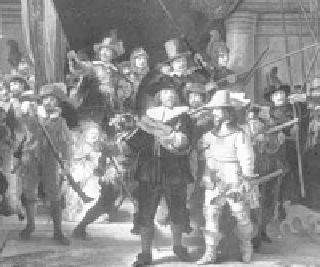Travel Reference
In-Depth Information
broken eggshells and scattered
cookware symbolize waste and
extravagance. The neglected
proverb tacked to the fireplace
reminds us that children will
follow in the footsteps of their
parents. The father in this jolly
scene is very drunk—ready to
topple over—while in the foreground his mischievous daughter
is feeding her brother wine straight from the f lask. Mom and
grandma join the artist himself (playing the bagpipes) in a lively
sing-along, but the child learning to smoke would rather follow
dad's lead.
Golden Age Dutch families were notoriously lenient with
their kids. Even today, the Dutch describe a rowdy family as a “Jan
Steen household.”
• Room 12 is dominated by...
Rembrandt—
The Company of Frans Banning Cocq
(a.k.a.
The Night Watch,
1642)
• The best viewing spot is to the right of center—the angle Rembrandt
had in mind when he designed it for its original location.
This is Rembrandt's most famous—though not necessarily
greatest—painting. Done in 1642 when he was 36, it was one of
his most important commissions: a group portrait of a company of
Amsterdam's civic guards to hang in their meeting hall.
It's an action shot. With flags waving and drums beating, the
guardsmen (who, by the 1640s, were really only an honorary mili-
tia of rich bigwigs) spill into the street from under an arch in the
back. It's “all for one and one for all” as they rush to the rescue of
Amsterdam. The soldiers grab
lances and load their muskets.
In the center, the commander
(in black , w ith a red sash)
strides forward energetically
with a hand gesture that seems
to say, “What are we wait-
ing for? Let's move out!” His
lieutenant focuses on his every
order.
Rembra ndt caught t he
optimistic spirit of Holland
in the 1600s. Its war of independence from Spain was heading to
victory and the economy was booming. These guardsmen on the
move epitomize the proud, independent, upwardly mobile Dutch.
Why is
The Night Watch
so famous? Compare it with other,






















